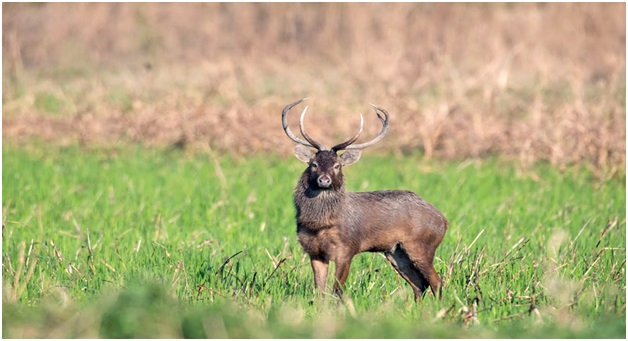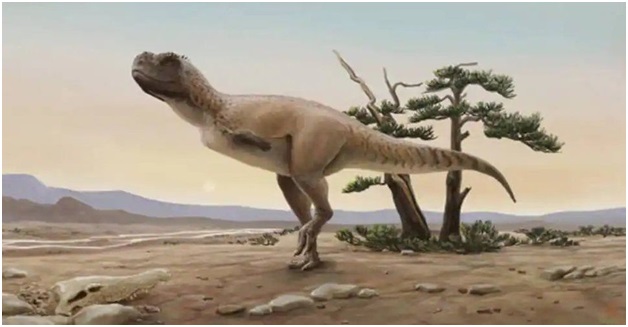Sangai Deer (Indian Express)

- 25 Nov 2023
Why is it in the News?
The Manipur Government has expressed its reservations to the Centre over a hydro-electric modernisation plan in the state’s famous Loktak Lake saying it could be detrimental to the endangered species of Sangai deer apart from disturbing the biodiversity of the lake.
About Sangai Deer:
- The sangai is an endemic and endangered subspecies of Eld's deer found only in Manipur, India.
- It is also the state animal of Manipur.
- Its common English name is Manipur brow-antlered deer or Eld's deer and the scientific name is Rucervus eldii eldii.
- It is believed to have originated from a common ancestor of the brow-antlered deer family, which is thought to have existed in the region during the Pleistocene epoch, around 12,000 years ago.
- Its original natural habitat is the floating marshy grasslands of the Keibul Lamjao National Park, located in the southern parts of the Loktak Lake, which is the largest freshwater lake in eastern India.
- Appearance: is a medium-sized deer that is unique in appearance and behavior.
- The Sangai deer is a slender and graceful deer, with long legs and a thin neck. They have a height of around 90-100 cm at the shoulder and can weigh between 70 to 120 kg.
- Food Habits: The Sangai deer is primarily found in the marshy wetlands of the Loktak Lake in Manipur, where they feed on the vegetation growing on the floating biomass called “Phumdis.”
- They are known to feed on a wide variety of plants, including grasses, sedges, and herbs.
- Vulnerable Species: The Sangai is an endangered species and is listed in Schedule I of the Indian Wildlife Protection Act of 1972.
- The population of Sangai deer has been severely threatened due to habitat loss, hunting, and poaching.
- In the 1950s, the population of the Sangai deer was estimated to be around 600-700 individuals.
- However, by the 1970s, the population had declined to less than 100 individuals due to extensive hunting and habitat loss.
- The Government of India and the State Government of Manipur took several conservation measures, including the establishment of the Keibul Lamjao National Park in 1977, to protect and conserve the Sangai deer.
- The Sangai deer is a social animal and is usually found in small herds of 2-20 individuals.
- Protecting and conserving their natural habitats is one of the most effective ways to ensure the survival of these species.
- This can be achieved through the creation and management of protected areas, such as national parks and wildlife reserves, and the restoration of degraded habitats.
Digital Twins (TOI)

- 25 Nov 2023
Why is it in the News?
Recently, the Survey of India (SoI) and Genesys International, a prominent Indian mapping company, revealed a strategic collaboration for the implementation of a three-dimensional (3D) digital twin-mapping initiative in India.
About Digital Twin:
- Digital twins are digital representations of physical objects, people or processes.
- They aid decision-making through high-fidelity simulations of the twinned physical system in real-time and are often equipped with autonomous control capabilities.
- These replicas serve as dynamic and detailed counterparts, providing a real-time, data-driven simulation of their physical counterparts.
- The concept of digital twins has gained prominence with the advent of technologies like the Internet of Things (IoT), data analytics, and machine learning.
- In essence, a digital twin continuously collects and processes data from its physical counterpart, offering a comprehensive view of its behavior, status, and interactions.
- This real-time synchronization enables organizations to monitor, analyze, and understand the performance of physical assets or processes more effectively.
Applications:
- Manufacturing Sector: One primary application of digital twins is in the manufacturing sector.
- Manufacturers use digital twins to create virtual models of products and production processes.
- This allows for simulation, analysis, and optimization before physical prototypes are built, leading to reduced development costs and improved product quality.
- Healthcare: In healthcare, digital twins are employed to create personalized models of patients.
- These models, based on individual health data, help in predicting health outcomes, optimizing treatment plans, and advancing medical research.
- Transportation: Transportation industries utilize digital twins for optimizing logistics and predictive maintenance.
- For example, digital twins of aircraft engines can simulate performance under various conditions, aiding in proactive maintenance and minimizing downtime.
- Urban Planning: Urban planning benefits from digital twins by creating virtual models of entire cities.
- This assists in designing and optimizing infrastructure, managing resources efficiently, and planning for future growth and development.
- Industries: In industrial settings, digital twins of production processes enable real-time monitoring, troubleshooting, and optimization, leading to increased efficiency and reduced downtime.
Farlowichnus rapidus (The Hindu)

- 25 Nov 2023
Why is it in the News?
Brazil's geological service recently announced a new species of dinosaur, a speedy animal that lived in the desert during the early Cretaceous period.
About Farlowichnus Rapidus:
- The new species of dinosaur was a small carnivorous animal about the size of a modern-day seriema bird, or about 60-90 cm (2-3 feet) tall.
- it was a very fast reptile that ran across the ancient dunes.
- These fossilized dinosaur "trackways," were first found in the 1980s by Italian priest and paleontologist Giuseppe Leonardi in the city of Araraquara, in Sao Paulo (Brazil).
- It lived during the early Cretaceous period.
About Cretaceous Period:
- The Cretaceous Period, spanning from approximately 145 to 66 million years ago, represents the third and final epoch of the Mesozoic Era.
- It is characterized by significant geological and biological events.
- The climate was generally warm, and the world's continents were positioned closer to their present locations.
- The Cretaceous witnessed the proliferation of diverse and iconic dinosaurs, including the formidable Tyrannosaurus rex and the enormous herbivorous sauropods.
- Additionally, flowering plants, or angiosperms, experienced a remarkable evolutionary expansion during this period, transforming terrestrial ecosystems.
- Towards the end of the Cretaceous, a catastrophic event, possibly a large asteroid impact, led to the mass extinction of dinosaurs and numerous other species, marking the boundary between the Cretaceous and the subsequent Paleogene Period.
- This extinction event profoundly shaped the course of Earth's biological evolution.
Deepfakes (TOI)

- 25 Nov 2023
Why is it in the News?
The government has warned top social media and internet companies that their platforms may be temporarily suspended and even be ordered blocked in case they are unable to tackle the menace of deepfakes.
What are Deepfakes?
- The term "deepfake" combines the concepts of deep learning with the fabrication of content.
- Deepfakes involve the creation of synthetic images and audio using machine-learning algorithms, intending to disseminate misleading content by replacing a real person's appearance, voice, or both with artificially generated likenesses or voices.
- These manipulated creations can either depict nonexistent individuals or simulate real people engaging in actions or utterances they never did.
- Originating in 2017, the word "deepfake" emerged when a Reddit user named "deepfakes" shared explicit videos featuring celebrities.
- The process of crafting deepfakes utilizes machine learning models employing neural networks to manipulate visual and auditory elements.
- To generate a convincing deepfake video, creators train the neural network on extensive real footage of the targeted person, facilitating a realistic understanding of their appearance from various angles and lighting conditions.
- This trained network is then combined with computer graphics to overlay the person onto a different actor.
- Regrettably, this technology is increasingly exploited for malicious purposes, including scams, celebrity impersonation, election interference, social engineering, disinformation attacks, identity theft, and financial fraud.
- The distinguishing factor of deepfakes lies in their challenging detection due to their sophisticated nature.
Sundarbans Tiger Reserve (STR) (Indian Express)

- 25 Nov 2023
Why is it in the News?
The annual tiger census in West Bengal’s Sundarbans is scheduled to commence on November 27.
About Sundarbans Tiger Reserve (STR):
- Sundarbans Tiger Reserve (STR) is situated in the coastal districts of West Bengal, i.e. South 24- -Parganas and part in North 24-Parganas.
- It lies at the southernmost extremity of the lower Gangetic delta bordering the Bay of Bengal.
- It is one of the first nine Tiger Reserves declared under the Project Tiger scheme in the year 1973.
- It is the only mangrove forest throughout the world (besides Bangladesh) to harbour a significant tiger population.
- Borders: The Sundarbans Tiger Reserve is bound on the east by the international boundary with Bangladesh formed by the rivers Harinbhanga, Raimangal, and Kalindi.
- On the south lies the Bay of Bengal.
- The western border is formed by the river Matla, which acts as a common boundary with the territorial Forest Division of South 24- Parganas.
- Towards the northwest, the area is bound by rivers Bidya and Gomdi.
- The Sundarban Tiger Reserve is a part of the Sundarban Biosphere Reserve.
- It harbours significant populations of the river terrapin (Batagur baska), which was once believed to be extinct.
- It is the nesting ground for marine turtles like Olive Ridley (Lepidochelys olivacea), Green sea turtle (Chelonia mydas), and Hawksbill turtle (Eretmochelys imbricata).
- Flora: These comprise true mangroves or major elements, minor elements of mangroves or/and mangrove associates, shrubs, non-halophytic non-mangrove associates, halophytic herbs, shrubs, weeds, epiphytes, and parasitic plants.
- Fauna: It is to a large number of endangered and globally threatened species like the tiger (Panthera tigris tigris), fishing cat (Prionailurus viverrina), and estuarine crocodile (Crocodilus porosus), Gangetic (Platanista gangetica) and Irrawaddy Dolphin (Oracella brevirostris), king cobra (Ophiophagus hannah), water monitor lizard (Varanus salvator), etc.
